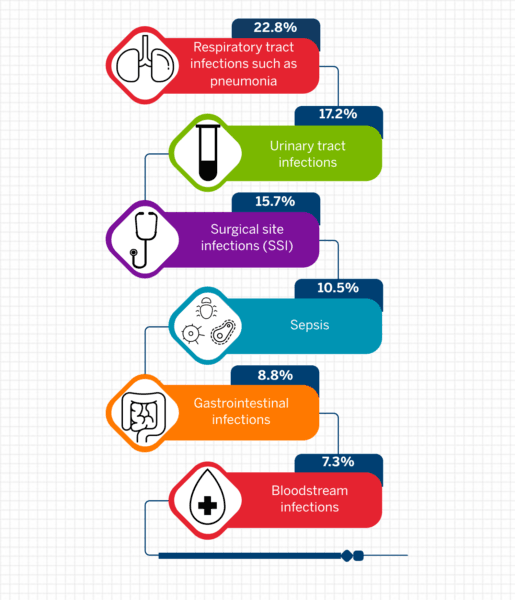Managing and handling infectious linens, workwear, and other textiles is of the utmost importance when it comes to healthcare surroundings. The transmission of infections within the healthcare sector is critical to keep both patients, healthcare professionals, and visitors safe. The term hygienically clean acts as a level and guide to refer to the reduction of pathogens. This term is used across various textile products at which the level of existing pathogens poses no threat to human illness. Hygienically clean linen means both: Hygienic (pathogen elimination); and Clean (inorganic removal, attractive appearance).
Healthcare-Associated Infections (HAIs)
HCAIs can develop either as a direct result of medical or surgical treatment or from being in contact with a healthcare setting. Research has shown that 1 in 31 hospital patients has at least one HAI. Often these types of infections are caused by Escherichia coli (E. coli), Staphylococcus aureus (S. aureus), and Clostridium difficile (C. difficile). C. difficile infections account for 5.6% of all infections within NHS England.
According to the NHS, the percentages for HCAIs within hospitals are as follows. 22.8% are respiratory tract infections such as pneumonia, 17.2% from urinary tract infections, 15.7% from surgical site infections (SSI), 10.5% due to sepsis, 8.8% from gastrointestinal infections, and 7.3% from bloodstream infections. It has been reported that on average 3.5% of patients who acquire an HCAI die from the infection.
There are several efforts and processes in place to reduce the prevalence of healthcare-associated infections (HAIs). These infections can cause serious harm to not only the host but also to staff, other patients, and visitors. This increase in risk can cause the NHS significant costs. Reports show that treating a patient who has an HCAI costs around three times more to manage than someone who hasn’t. This is primarily attributable to a patients’ increased length of hospital stay. Therefore, infection prevention and control is a key priorities for the NHS.
Contaminated Healthcare Linens
The use and environment that healthcare lines are used in, create the ideal breeding ground for bacteria and viruses. Research conducted by scientists at De Montfort University Leicester (DMU), found that traces of coronavirus can remain infectious for up to three days. A sheet under a patient’s body is dark, becomes warm from their body, and sometimes damp. The ideal conditions for bacteria and viruses to thrive. For this reason, it is important to prevent bacteria from living on garments and passing onto fabrics that could cause potential infections in patients.
NHS England has certain policies in place that aid healthcare professionals in the handling of contaminated textiles and fabrics.
- You should always wash your hands after handling a patient’s bed linens.
- You should hold soiled linen away from your uniform.
- Soiled linen is never shaken in the air to avoid contamination of air, surfaces, and people. Shaking can disseminate the micro-organisms they contain.
- Linen from one patient’s bed is never (even momentarily) to be placed on another patient’s bed.
- Soiled linens should be placed directly into a portable linen hamper or tucked into a pillowcase and the end of the bed before it is gathered up for disposal in the linen hamper or linen chute.
Research indicates that healthcare linens are known to harbour a number of microorganisms. Most notably, methicillin-resistant Staphylococcus aureus (MRSA) and vancomycin-resistant Enterococcus (VRE) can survive for several days on linens. Furthermore, these contaminated linens then become a potential source of cross-contamination.
Textile Management Best Practise
Public Health England (PHE) published guidance stating that industrial laundering should be used for healthcare worker uniforms. However, once hygienically cleaned textiles are delivered, it is paramount that they remain clean. Each hospital, therefore, requires a policy and procedure for handling the transportation and storage of clean and used textiles. Once textiles are removed from a clean-linen cart or storage room and taken into a patient room, they are considered contaminated. There are further tips and advice here on how contamination can be reduced.
Lindström can help safeguard from contamination
Having hygienically clean linen and the overall environment is a great responsibility and highly important. The focus of a healthcare professional should be on patient care. Therefore, healthcare textile management should be left to the experts. Here at Lindström, we understand all there is to know about ensuring hygienically clean textiles to use, at all times.
Outsource your non-core healthcare textile management to the experts
- Full rental and laundry service of garments
- Technology-enabled product life-cycle visibility
- Pricing transparency with no hidden costs
- Stock optimisation
- Inventory Management
- Eco-efficient washing
- Avoid payment for garments that you no longer require (free returns)
- No residual values at the end of the garment’s life
- No hidden costs
- On-demand availability and production
Contact Lindström today to find out more about our healthcare uniforms and how we can keep your staff, patients, and visitors safe. We have several clothing items available including nursing tunics, lab coats, medical trousers, medical scrubs, dental uniforms, and clean room clothes. Speak to our experts today and protect your working environment.
